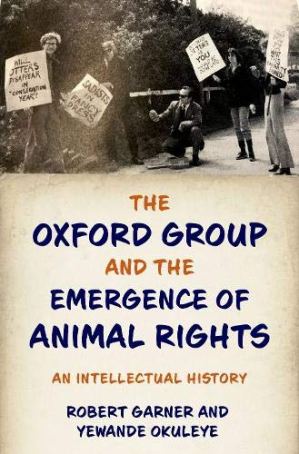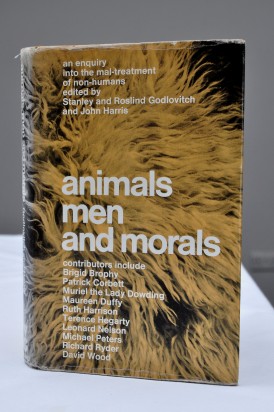Fifty years ago Oxford, like many other universities, was going through a phase of political restlessness and dissent, at least among its students and younger dons. National and local controversies made themselves felt on Oxford’s walls in graffiti of an anti-establishment kind. ‘F– Franks’ was painted in giant letters on the wall of Keble College, in reference to the recent Franks Report on the University’s governance. Balliol’s west wall was used as a lively social medium for opinions and protests. World peace, socialism, anarchism, and other noble futures were declared imminent with priggish self-confidence in countless rooms and halls: “the revolution’s here”, as the hit song said in the summer of 1969.
In all this, of course, the animal theme had almost no part. There was a University Vegetarian Society, but then there was a society for almost every strange interest. College kitchens would provide an omelette as the all-purpose meat-alternative for the very few who wanted it. As for veganism: the 1969 Oxford Dictionary addenda of new words was recognizing hippy, fuzz, and drop-out, but still not including vegan, though that word had been in use since 1944. Academically too, the theme was invisible. The study of philosophy at Oxford was mainly devoted to linguistic analysis, ‘talk about talk’. Moral Philosophy involved discussion of key concepts such as ‘good’, and ‘duty’ in the abstract, or there was ‘meta-ethics’, which questioned whether our moral judgements had any communicable validity or were merely expressions of personal feeling, the consensus being in favour of the latter interpretation. Of applied ethics, a staple of philosophy departments nowadays, there was no official teaching at all.
As to the life-sciences, this was almost certainly the most profligate period so far in the University’s hundred-year history of vivisection (but no numbers were published, or even perhaps kept). The back parts of the physiology building smelled of distressed animals, and experiments using cats and monkeys in careless quantities were routine. After all, Oxford was a centre of vivisection in a nation which was at this time using about five million animals a year in its laboratories. To supervise all this, the Home Office was providing eleven inspectors.
Then in the Hilary Term of 1970 those same numbers were advertised in a remarkable leaflet composed by Richard Ryder and distributed by him round Oxford’s churches, schools, shops, and colleges. The witty and prodding text introduced the concept and word ‘speciesism’ (Ryder’s invention). Readers were told something about the practice and ethics of vivisection, and urged to contact “MPs, professors, editors about this increasingly important moral issue.” It was a heroic individual effort by someone who, as a psychiatrist working at Oxford’s Warneford Hospital, was taking a professional risk with it. And the University, in the person of Professor of Pharmacology William Paton, did indeed complain to the Warneford authorities about Ryder’s campaigning.
But there was by now a small band of people at Oxford, mostly post-graduate students, who shared Ryder’s concerns. Their thinking and their discussions were genuinely counter-cultural, as opposed to the ubiquitous bolshevism of student fashion, and together with Ryder they would soon produce an even more notable publication, the collection of essays titled Animals, Men and Morals (1971). This daring and momentous book would revive animal rights as a serious public controversy after a long period of disuse, and show also, by example, that the claims of animals deserved the attention of academic philosophers.
This ‘Oxford Group’ (again, Ryder’s coinage) numbered ten people – three married couples and four others – though for their book they had help and contributions from several other people from outside Oxford who were already involved in animal protection. How these ten met, and how they collectively created in that inhospitable Oxford environment (even today it’s not an animal-friendly scene) a corpus of thought which still reads with subversive power, is now the subject of a full-length book, The Oxford Group and the Emergence of Animal Rights: an Intellectual History, by Robert Garner and Yewande Okuleye. This book  records, mainly through interviews with former members of the Group, the key relationships and influences, the discussions and the shared meals, through which their moral convictions took considered form. It’s oral history, then, and there is vivid and extensive quotation, with many telling moments recorded: the ethical ‘epiphanies’; the dietary adventures (“Peter and Renata for dinner. Protoveg stroganoff, noodles, peas, olives, white wine. Nice visit.” says a diary entry); the slightly bashful demonstrations outside St Michael’s Church in central Oxford (Richard Ryder was the only natural activist among them at that time); the intellectual walks, including the one that took two of them past the body of a bird, killed by traffic (“If that were a dead person . . . they wouldn’t just leave the body beside the road”).
records, mainly through interviews with former members of the Group, the key relationships and influences, the discussions and the shared meals, through which their moral convictions took considered form. It’s oral history, then, and there is vivid and extensive quotation, with many telling moments recorded: the ethical ‘epiphanies’; the dietary adventures (“Peter and Renata for dinner. Protoveg stroganoff, noodles, peas, olives, white wine. Nice visit.” says a diary entry); the slightly bashful demonstrations outside St Michael’s Church in central Oxford (Richard Ryder was the only natural activist among them at that time); the intellectual walks, including the one that took two of them past the body of a bird, killed by traffic (“If that were a dead person . . . they wouldn’t just leave the body beside the road”).
That last quotation is from the recollections of Peter Singer, but the speaker and acting moral tutor at the time was Stanley Godlovitch, who had been already a convinced vegetarian when he came to Oxford from Canada in 1968, and was accordingly a key persuader. But yes, Singer naturally has a leading part in the book. He arrived slightly later than the others. Animals, Men and Morals was already in the making, and he did not contribute, but his review of it later on for the New York Review of Books led to his own Animal Liberation (1975), a more compelling title and in time a much more successful book. Accordingly Singer rose professionally with the subject more than any of the others, going their own various ways as they did.
However, it’s one of the merits of The Oxford Group that it shows the collectivity of the ideas at that time and re-distributes their ownership (as Singer himself, least arrogant of celebrated thinkers, very willingly does in his interviews for the book). In particular it highlights the importance of Richard Ryder, less famous now than Singer but in fact a hero of the animal rights movement, who in any other sphere of the UK’s public life would surely have been honoured in some way by the state for his services.
Then there was Roslind Godlovitch. Like her husband Stanley, Roslind was a strong persuasive influence on Singer and the others. She had already published a pioneering article in the journal Philosophy, which she adapted for her chapter in Animals, Men and Morals. This is a witty and polemical piece, still illuminating and authoritative now. She contemplates the contemporary ethical notion that, although animals should be protected from suffering when possible, their lives in themselves have no moral value, and she subjects it to a contemptuous reductio ad absurdum, showing that our logical course should therefore be “to exterminate all animal life.” She then suggests, much as Jonathan Swift might have done, how governments and charities could collaborate to achieve this end. But in fact, as she says with moving absoluteness, “there is nothing to indicate that an animal values its life any less than a human being values his” (the ‘his’ is perhaps of its period; the statement itself is surely for all time). Roslind Godlovitch, who discontinued her post-graduate research and wrote nothing further about animal ethics, is one of the five members of the Oxford Group to whom Singer dedicated Animal Liberation.
Richard Garner, the lead author of The Oxford Group, is a notable and well-published proponent of animal rights. In particular he has argued, as a political scientist, for the incorporation of animal interests in the political system. But for this study of ideas he has expressly chosen to be impartial as to the quality of the arguments involved: “agnostic” is the term he uses. That seems wise for a historian and interviewer, and the arguments speak adequately and indeed passionately for themselves, or rather for the personalities who are recorded as proposing them. But Garner has gone further and cast the whole story as a sociological study, illustrating “the social construction of knowledge”, or how humans collaborate to create ideas and give them currency.
It makes for a clear organizing principle, certainly, but I would say also an unfortunate one. It’s not just that the dead hand of sociological jargonizing lies heavily upon some parts of the text, but I shall take that first. It especially affects the opening chapter, which lays out the theoretical machinery and will surely tend to alienate the common reader and doom the book to the shelves of university libraries (though the price may do that anyway). For instance this, by way of providing some theory for the interviews: “The dynamics of an oral history interview is usually centred around the intersubjectivity between the interviewer and interviewee.” I choose this sentence partly as a sample of sociology’s habit of disguising the patently obvious in nebulous abstracts, and partly to illustrate the baleful influence which this habit of abstract diction has on ordinary nearby English: “dynamics is”? “”centred around”?
But perhaps more unfortunate is the incongruity between this study-bound theory and the energy, urgency, and sense of revelation which (as the book clearly shows us) animated the members of the Oxford Group. That encounter with the dead bird, for instance, so immediate and also so emblematic (Albert Schweitzer saw a dead insect as both a lesson and a real presence in just the same way), is part of a section intended to illustrate “the Role of the Gatekeepers”. That’s “in Farrell’s terminology”, Professor Michael Farrell being the chief supplier of sociological theory to the book – and the reader comes to dread his name, academically distinguished as it no doubt is.
I would finally add that, as David Wood argues in his chapter of Animals, Men and Morals, jargon is a notorious enemy of clear moral awareness. He titles the chapter ‘Strategies’ (i.e. strategies to conceal what’s really happening to animals) and shows how “a huge pattern of jargon” has been deployed with great success to obscure the realities of meat and dairy production. Again, therefore, the use of this sort of abstract and distancing language in The Oxford Group is painfully incongruous.
Still, the story easily escapes this theoretical cage, and it’s a fascinating, exciting, and moving story, whose importance is growing all the time. In his ‘Postscript’ to Animals, Men and Morals, Patrick Corbett (of Balliol, but by 1970 a professor at Sussex) says “we want to change the world.” How many of the restless spirits at Oxford in the late 1960s were thinking and saying that! So many of their projects came to nothing, and often enough it’s just as well they did. But here was one that most fortunately did not. Sadness we must feel that it continues to be relevant and urgent fifty years on, but profound gratitude too for the originality and fervour of that band of ten – and of course gratitude also, despite my carping, towards the authors who have now given the Oxford Group its proper history.
Notes and references:
The Oxford Group and the Emergence of Animal Rights: an Intellectual History, by Robert Garner and Yewande Okuleye, is published by Oxford University Press, price £47.99. Please note that the date of publication was 17 December 2020, and this review of it uses a proof copy only. There will have been changes, and accordingly I don’t give page references.
The song quoted is Thunderclap Newman’s ‘Something in the Air’, which was top of the hit parade for a while in July 1969, but Bob Dylan’s ‘Times They Are a-Changin’, with its stern advice to “mothers and fathers . . . don’t criticize what you don’t understand”, would summarize the outlook just as well.
The new words are listed in the ‘Addenda’ to the 4th edition of the Little Oxford Dictionary, OUP, 1969.
The text of Richard Ryder’s 1970 leaflet is provided at pp. 44-5. Professor Paton later wrote a defence of animal research, Man and Mouse: Animals in Medical Research, OUP, 1984.
Animals, Men and Morals, edited by Stanley and Roslind Godlovitch, was published by Victor Gollancz. Quotations are from pp. 168 and 164 (Godlovitch chapter), 199 (David Wood), and 232 (Patrick Corbett). Contributors from outside the Oxford Group included Ruth Harrison, Brigid Brophy (who partly organised the project), Muriel Lady Dowding, and Maureen Duffy.

 its political forms. The chapter on vivisection was written by Richard Ryder, then a psychologist in an Oxford hospital, and since that’s the unhappy subject of this blog I shall say a little more about his part in the book.
its political forms. The chapter on vivisection was written by Richard Ryder, then a psychologist in an Oxford hospital, and since that’s the unhappy subject of this blog I shall say a little more about his part in the book.